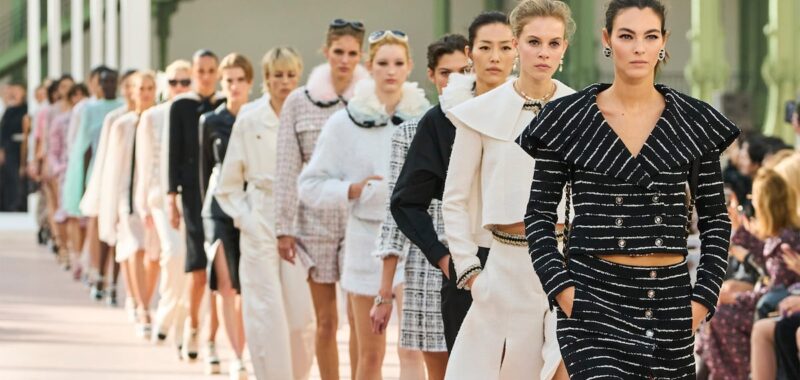PARIS â Relevance is a word that hangs heavy over fashion. It makes what you do count. Or not. So much of what weâre seeing on catwalks is entertaining but entirely irrelevant. Leave it to Miuccia Prada to beat such a notion into submission on her Miu Miu catwalk on Tuesday. She engaged artist Goshka Macuga to design a newspaper called âThe Truthless Times,â which, in a very convincing illusion, was in production over the audienceâs heads as the show progressed. A film by Macuga was also screened, starring Pathos and Logos. âThe pursuit of truth has turned into a prison,â said one to the other. Who controls the narratives? Outside fashionâs fortress walls, the horrendous news cycle keeps on churning
If Macugaâs work questioned the human experience of reality, Miucciaâs collection reassuringly asserted a human physicality. Girl du jour Loli even sported a sprinkle of glitter on her top lip, like a little line of sweat. And there was a steaminess to crushed slip dresses, unbuttoned down the back. The casual sensuality made me think of Tennessee Williams. And then, right on cue, Big Daddy Willem Dafoe took to the catwalk.








Those unbuttoned backs were a feature, in dresses of plain white cotton. Or at least they were plain until Miuccia dabbed them with globs of sequins or splashes of elaborate embroidery. The naivete of the collection harked back to the challenging aesthetic of Prada three decades ago, but the sense of Miuccia re-engaging with her past is what made it so exciting. A suede jacket (didnât she always say she hated suede?) paired with a vinyl pencil skirt reeked of the John Waters-style bad taste that enlivened Miu Miuâs golden era. The armlets were so bad they were good. Just like the butch belts, slung round the elasticated waists of little cotton skirts. With Miu Miu, the message was so often mixed, and Miuccia left it to us to go figure. So why does that feel more relevant than ever?
You have to pose the same question about Chanel. While the speculation about a new designer mounts, this one was designed by the âCreation Studio,â in other words, the design studio, who did a perfectly fine job of meeting the expectations of Chanelâs loyal clientele around the world. At which point you wonder how much this clientele even cares whose actual name is on the finished product. Itâs all Coco as far as theyâre concerned.
We were back in the Grand Palais, the Chanel brandâs spiritual home, which, after its renovation for the Olympics, was as grand and soulless as ever. Its cavernous space was the death of the showâs disco soundtrack, turning it in to a train station tannoy of booming beats, which was offputtingly earthbound given that the theme of the collection was birds in flight. The runway (and never was that word more appropriate for the length of the catwalk) centred on a giant birdcage with a swing, which evoked memories of Jean Paul Goudeâs entirely fabulous 1991 commercial with Vanessa Paradis for Chanel No. 5. Sure enough, a chanteuse mounted that swing at showâs end to sing Princeâs âWhen Doves Cry,â in keeping with the birdly theme. Turns out, it was Elvisâs granddaughter Riley Keogh. Karl would have appreciated that. Coco maybe less so.





Feathers were everywhere, as collars, as cuffs, as extravagant plumes on Mariacarla Bosconoâs plain black suit. Edie Campbellâs flying suit was buckled with a solid silver feather. Chiffon capes, swing jackets, flippy slit skirts, and flowing georgettes printed with multi-coloured feathers underscored the message of airy lightness. A cardigan over shirt tails exemplified the almost throwaway ease of the collection, which made the clumpy platform shoes a peculiar downer. How different would this collection have looked with a marquee creative director? I guess weâll find out next season.
While the stalwarts of the fashion media with any energy left headed out to Disneyland Paris for the Coperni event, the last show of the Spring 2025 season was, to all intents and purposes, Louis Vuittonâs presentation in the Louvre. Nicolas Ghesquiereâs historicism was in full effect, with puff sleeves, full skirts, trains, frills over jewelled knickerbockers, ruffled dresses studded with cabochons, Scheherazade sequins and chiffon harem pants. I kept wondering where you would meet such outlandish creatures, as opposed to the human beings who walked the Miu Miu catwalk. Mind you, there were bags – so many bags – and that was surely the thing that mattered more than flesh and blood, because they are, after all, the throbbing pulse of the LV business. The show even took place on a catwalk built from Vuitton trunks, the brandâs original calling card.





It was lovely listening to Jamie XXâs new album on an expensive sound system. And the last three looks featured luscious oversized shirts printed with paintings by French artist Laurent Grasso, who absorbs paranormal phenomena into his work. They had an eerie quality, like 21st century revisions of John Martinâs sensationally apocalyptic work from the 19th century. Maybe more of that âendcoreâ feeling we read about in Miu Miuâs newspaper. Apropos of which, it strikes me that, after 16 days of looking at fashion in London, Milan and Paris, the only person who directly referred to what is happening right in front of us in the Middle East was Donatella Versace. Once upon a time, fashion prided itself on reflecting reality. Creativity engaged. Now, fashion keeps itself safe in its notorious self-referential bubble, choked by corporate caution. They called it âsoft powerâ in the LV show notes. Hardly convincing when bubbles are notoriously fragile. They burst. I feel Iâve said that already this season. Doesnât make it any less true. There are so many blinding young talents in fashion. The world is literally dying to hear their voices.

